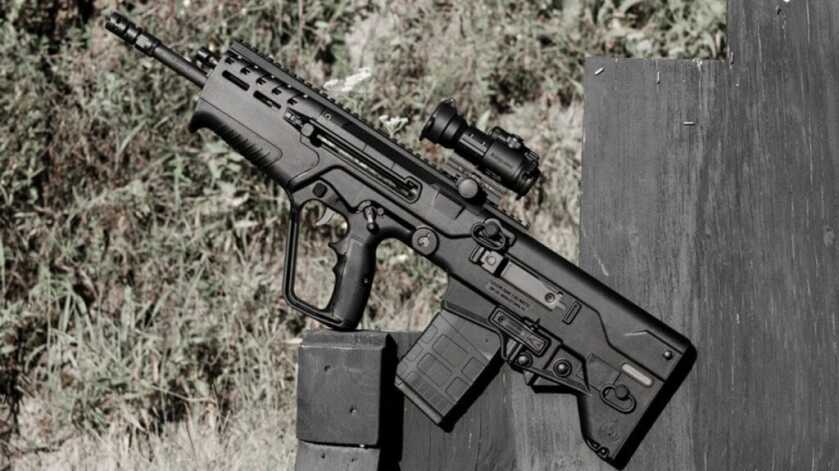
Let’s get something out of the way right upfront. I’m not an expert rifle guy. Sure, I know that the skinny end should point toward the target, but many of the finer points seem like voodoo magic to me. But that’s okay because the Tavor is called a Bullpup, a QCB weapon, a Combat gun, etc. Those names are more forgiving to those of us who generally know our way around a rifle but are not going to impress any real experts with knowledge or experience.
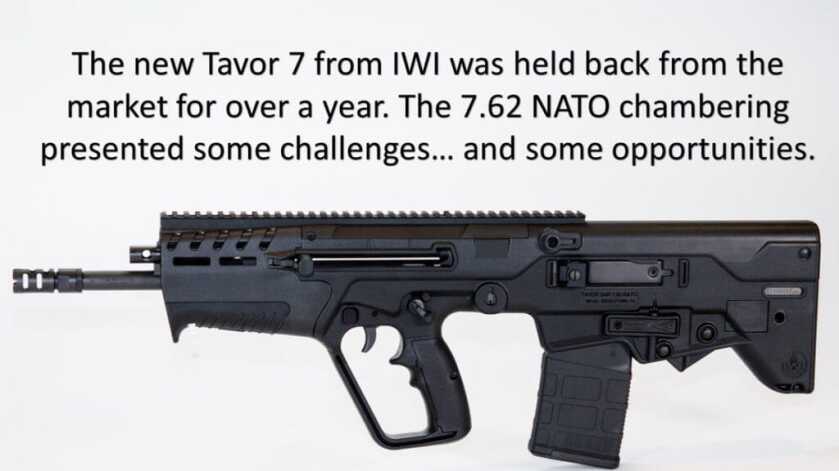
Confession number two: I’d never fired a Tavor before. That includes the X95 upgraded variant that is probably the most popular model. No reason, really – just never stumbled upon an opportunity to do so. I’m guessing there are a few readers out there that have similar stories, and yet are (as I am) drawn to the Tavor design. When given the chance to evaluate and report on the newest from IWI – the Tavor 7 – I was very interested. First, because the now almost legendary Tavor has so long eluded me, and second because this one stretches the playing field by being chambered for 7.62 NATO (or .308 Win). That just sounded a little too badass to pass up.
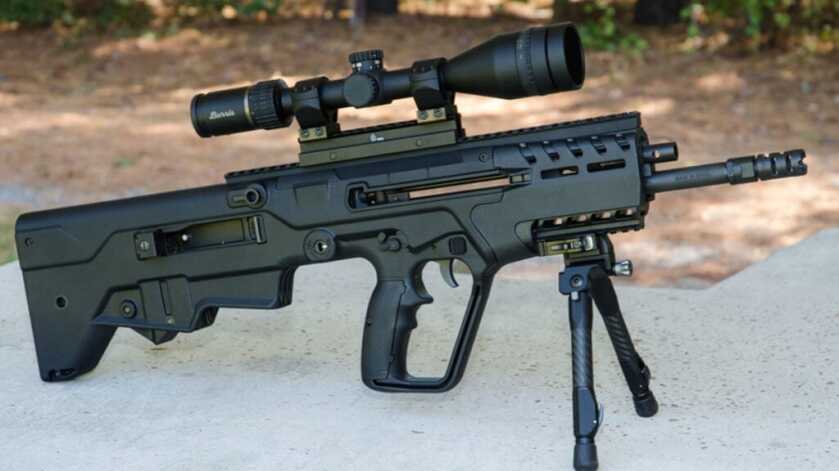

My first impression of the Tavor 7 was, “Wow, this thing is heavy”. At a full 9 lbs. it’s more bull than pup. But it wears that weight well, and I think it is to the benefit of the shooter. More on that in a bit. My second impression was “What do you mean it doesn’t come with any sights?”. Yes, I get that most users will immediately mount their optic of choice, but I think a QCB gun should have a set of flip-up sights on it out of the box.

I had to wait a couple of days for the ammo I’d ordered to arrive, so I spent some time getting acquainted with the rifle and its controls. I even read the manual, at the risk of losing my man card. Before hitting the range with the T7 I was already impressed with not only the quality of materials and workmanship but with the clever design and especially the upgrades that it has over previous models. I don’t want to have to take a class at the local community college to learn how a new rifle works, and I was pleased to find the Tavor 7 very intuitive and user-friendly. And, it is more left-hand friendly than its predecessors, with many controls being fully ambidextrous. The remaining functions of the rifle can be easily switched from right-hand use to left-hand use, even in the field – using no tools other than a single round of ammo. This includes not only swapping over the charging handle but also changing ejection from one side to the other. All with no extra parts required. For a combat rifle that may need to change hands often, this is huge.
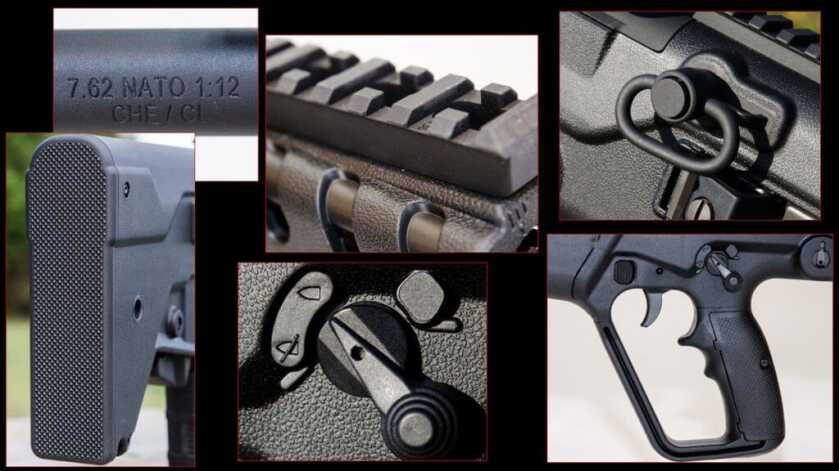
SHOOTING THE TAVOR 7
Opinions are mixed about the inherent accuracy of the 7.62 NATO and .308 Winchester, but no one can dispute that it is one of the most tested rounds in existence and capable of producing trophy-taking groups at great distances. Initial prototypes of the Tavor 7 were met with groans of disappointment from the shooting community when it could not produce groups close to 1 MOA. In fact, it was producing groups closer to 4 MOA and that was generally considered unacceptable. So, IWI held back on the planned release of the gun, vowing to improve that – with a goal of achieving 1.5 MOA on the final production rifle. That was well over a year ago. Did they meet that goal?
Jeremy Gresham, Director of Sales and Marketing at IWI US made the following statement recently on social media:
“This will be the final update on the T7 before we start shipping… For a better part of a year and a half of extra testing on the rifle, we have come to the conclusion that the Tavor 7 will not get the accuracy of 1.5 MOA that we set out to get. Overall the weapon system as a whole was never designed in a way to achieve this 1.5MOA. It was designed to shoot minute of man on today’s battlefields with a high degree of reliability. In the last update I posted we got it down around the 1.5MOA but we gave up too much in other areas so that simply wasn’t the answer. After all this, the engineering team has put a major focus on accuracy going forward with new product development on top of what we already do well. We have shot more 308/7.62 NATO in the last year of testing than I believe most people will fire in a lifetime times 10. In conclusion, it’s a solid weapon system for what it was intended for and soon you’ll be able to get your hands on it.”
I knew two things about this rifle in advance of receiving it – that I wanted to shoot a lot of ammo through it; and that I didn’t want to break the bank doing it. I purchased several boxes of top-shelf ammunition, like Hornady Match and Winchester Silvertip, some general-purpose stuff with a good reputation like Federal American Eagle, and ordered a bunch of inexpensive ammo for volume shooting. That inexpensive ammo took two forms: Military surplus 7.62 NATO and steel-cased TulAmmo in .308. The Tula arrived first, and on my first range trip, I took a few hundred rounds of it, and a few boxes of Winchester Super X and Aguila. Thank goodness for those last two – because this rifle will just plain not shoot Tula ammo.

I spent about 30 minutes hearing the gun go “click” instead of “bang”, during which time I was able to actually fire fewer rounds that I could count on one hand. After examination, I believed the problem to be related to deeply seated primers and a firing pin that doesn’t quite extend far enough to reliably detonate them. Subsequent range trips did not include any of that ammunition and yielded no malfunctions of any kind.

I shot the Tavor 7 with several configurations at many distances using a variety of ammo. Military surplus ammo did the heavy lifting for just general shooting, semi-rapid fire, and heating up the gun for some endurance evaluations. For measured groups, I used several commercial loads through a cool and clean barrel. Results at 100 yards fell very much along the lines of “you get what you pay for” in terms of the ammo tested. As the price of the ammo increases, the size of the group decreases. As such, I think the top three performers are a good indication of the Tavor 7’s capability. The best 5-shot group I was able to produce at 100 yards was 3” with Winchester’s Silvertip 168 grain. Looking at the best 3-shot group for each load (which helps eliminate shooter inconsistencies), four out of six tested loads produced sub 1.5” groups. In light of Gresham’s statement, this is some good performance.
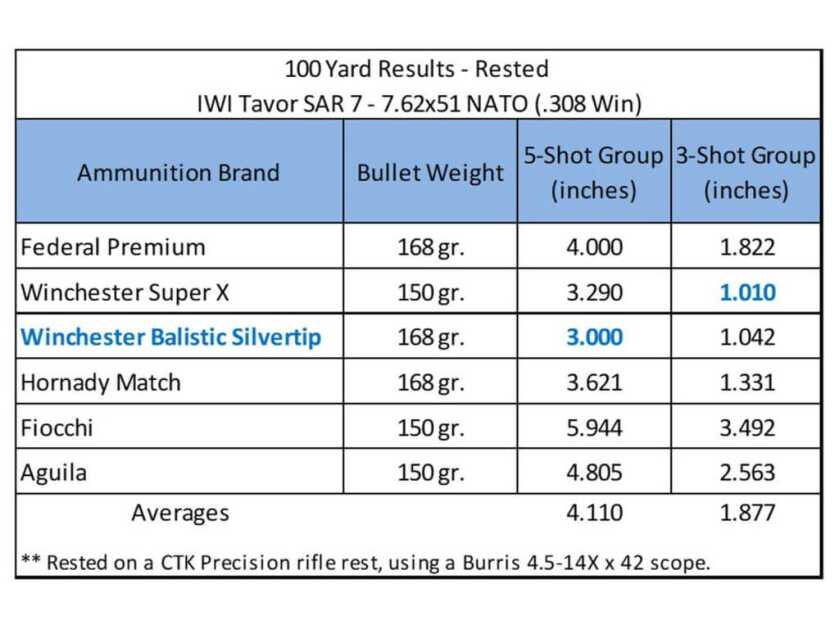
At a closer distance, like 50 yards, the Tavor 7 nearly makes ragged holes with just about every kind of ammo. I think this is truly where this gun shines. If you wanted a Tavor to hunt with, I think that you can do it with this 7.62×51 model – as long as you keep it to around 100 yards or so. For closer ranges, maybe wild boar – it should be an awesome choice.
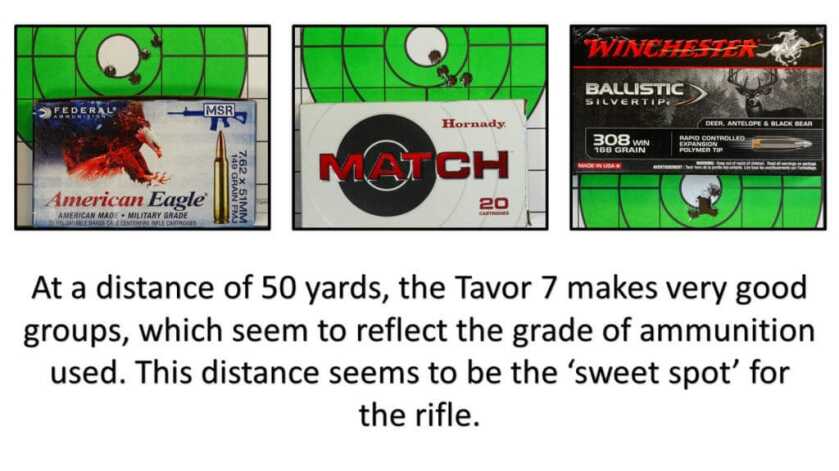
Accuracy wasn’t the only thing I was curious about before shooting the Tavor 7. I had premonitions of a bruised shoulder or battered cheek from the extra thump of .308 recoil in a small bullpup. So much so, that I must have looked comical when I leaned into an extra-wide stance for that first shot. Imagine my surprise to find that the gun shoots quite tamely! It’s still a .308 and the laws of physics still apply, but I do not find shooting this rifle to be unpleasant at all. I put several hundred rounds through it in a relatively short period of time without any discomfort, and no soreness afterward. This is a testament not only to the 9 lbs. of weight and the way it is distributed (toward the back) but also to the well-designed ergonomics. The Tavor 7 shoulders nicely, with a comfortable cheek weld. The pistol grip is at a pleasant angle with a comfortable grip surface, and the forward handguard provides a nice grasp at a comfortable distance. Although the butt of the rifle is surprisingly un-padded, it is well textured and large. This spreads the recoil energy over a larger portion of the shooter’s body and nearly eliminates any movement. I can honestly say that I have pistol caliber carbines that are far more abusive to the shooter.
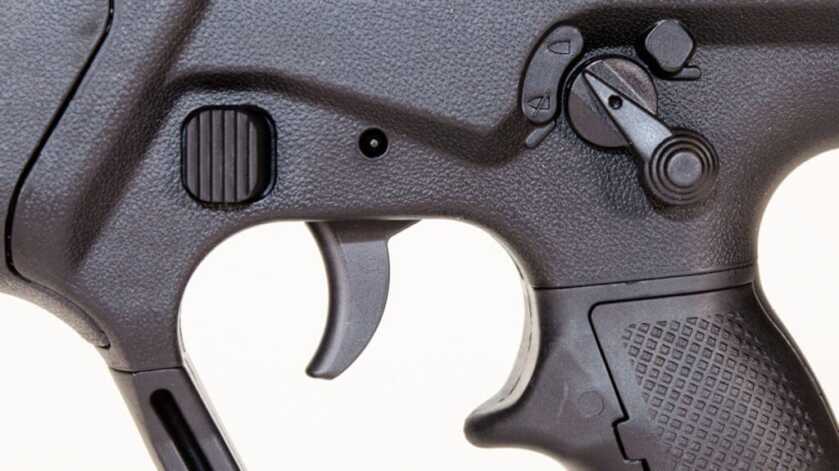
Bullpup rifles are also notoriously known for their bad triggers, but that is not the case with the Tavor 7. I find the trigger to be light and crisp without over-travel and a good reset. It measured just 4 ½ lbs. on the Lyman digital scale.
WHAT’S NEW FOR TAVOR 7?
As if simply chambering a bullpup for .308 isn’t enough to get the market’s attention, IWI made this rifle very well equipped, including several changes in answer to customer feedback from Tavor and X95. Starting out front, there is an adjustable gas system with four settings. Going from right to left (remember, this is an Israeli weapon, and Hebrew is read in that direction) they are R for regular use; A for adverse conditions; S for suppressed; and O for off. The settings are also numbered I through IIII. In the “Off” setting, the action will not cycle after the shot is fired. This is intended for extreme covert use, obviously in conjunction with a suppressor, when one does not wish to draw attention to herself.
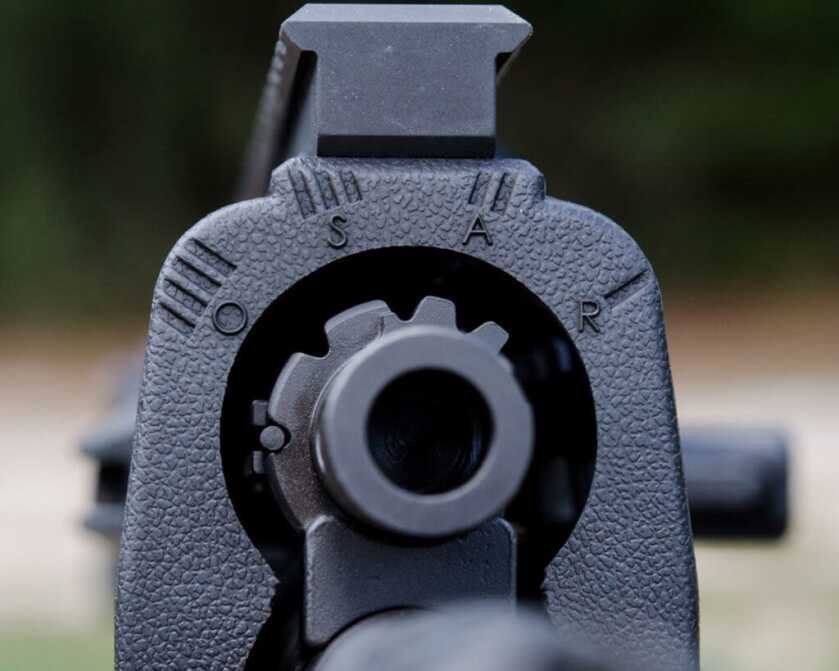
Sliding rearward just a tad, the foregrip has been changed so that only the bottom part is removable to reveal a generous section of 1913 Picatinny rail, but none on either side as the X95 has. The cover is easy to remove and replace once you know the secret to the button. I didn’t realize that you push only the right side and the manual was not clear – so it took communication with customer service to learn that the part wasn’t broken, I was just a dimwit. But even if you are a dimwit – the folks at IWI USA customer service are helpful and friendly.
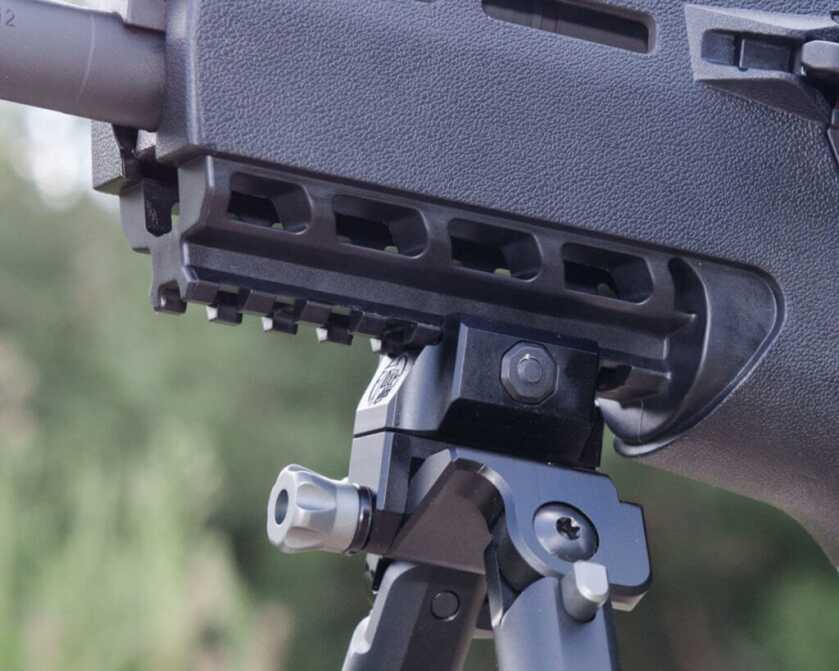
Next, the charging handle (which is fully reversible side-to-side) has a catch position (think HK or CZ) that allows you to lock the bolt open and then charge the weapon with the flick of a finger. This is quite possibly my favorite feature. The handle is non-reciprocating, so there is no danger of it hitting your support hand when firing, no matter how you grip it.
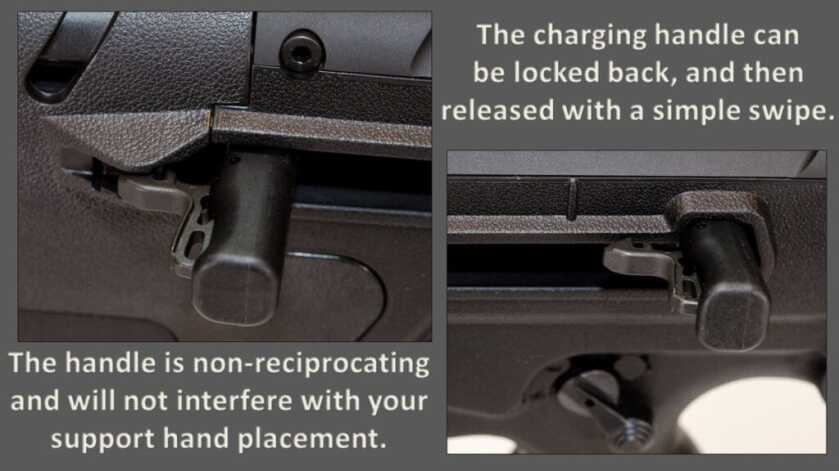
The top of the T7 is a single long run of 1913 rail, made of high-grade aluminum and well finished in matte black with graduations for reference when replacing optics. It is, however, barren of any sights as I have previously bemoaned. The magazine release is fully ambidextrous and the buttons are large and wonderfully serrated. Their location is nothing short of either pure genius or very good luck, and I’ll allow for the former. When I remove my finger from the trigger and rest it on the frame of the receiver, it falls naturally onto the magazine release. Depending on the length of your specific digits, your results may differ – but for me, it is in the perfect position to release the magazine and reload. And doing so is easy. The button offers just enough resistance to avoid accidentally dropping a magazine unintentionally but is easy enough to push deliberately and the magazine drops free every time. Of which, one Magpul 20-round PMAG is supplied.
The safety selector is also fully Ambi and well located for easy operation. The pistol grip is generally comfortable and ergonomic, but the large upper finger groove feels awkward to my hand and gives me the sensation that my second finger should be higher up. Something that bothers me less while shooting than it does just holding it. Also, in the box are two quick-detach sling swivels for the well-placed QD mount points on the gun.

But perhaps the biggest headline, aside from the chambering itself, is the ability to change the rifle from a fully right-hand shooter’s gun to a fully left-hand shooter’s gun – in just minutes – without tools or additional parts. You’ll hear some people call the Tavor 7 “fully ambidextrous”, but that’s incorrect. By definition, to be ambidextrous means that it can be manipulated with either hand equally without modification. The Tavor 7 is “easily convertible” to either hand use. And that’s still big news! The charging handle is easily moved side to side, the ejection ports are easily and quickly switched, and the bolt itself is easily converted from right hand to left. All capable of being done in the field using only a single live round as your tool.
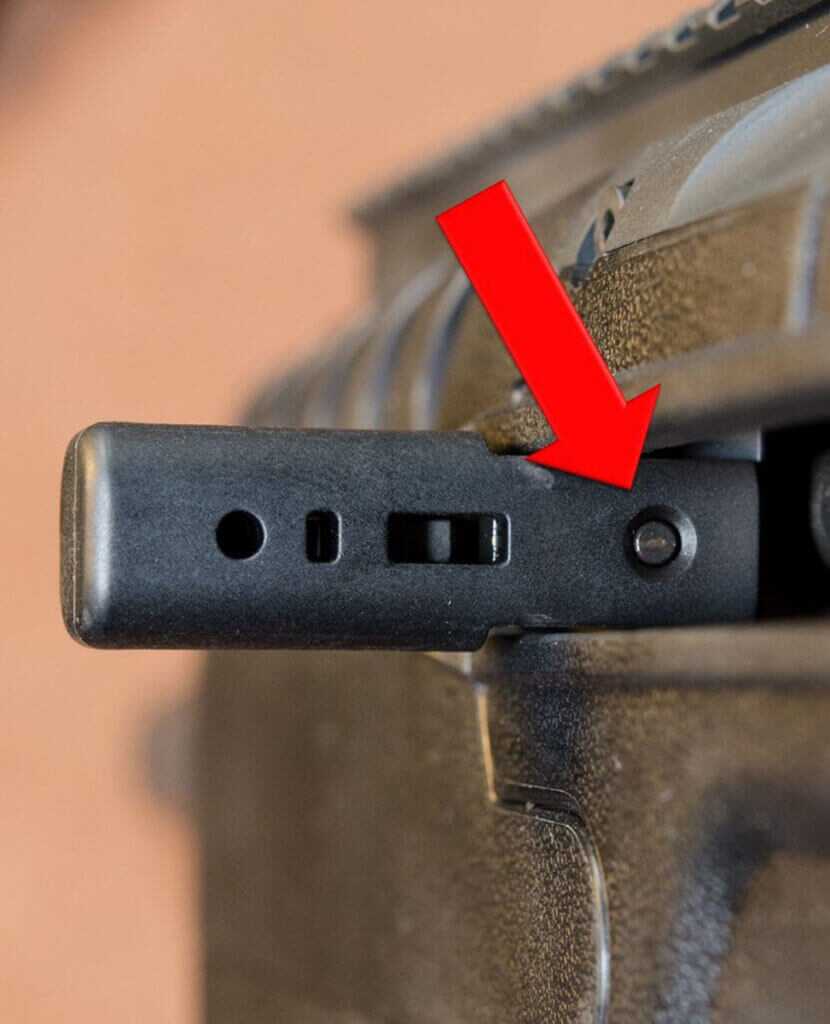
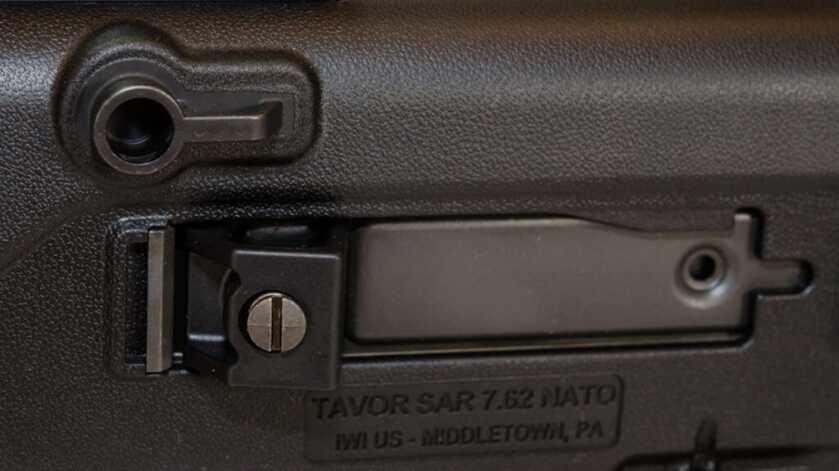

JUST MY OPINION
I began fieldwork with the Tavor 7 without many expectations and an open mind – perhaps the benefit of my lack of familiarity with the platform. I’ve mentioned my joy and surprise at the way the Tavor 7 manages the recoil of the .308, while not the most punishing round out there, certainly one that can leave an impression. The overall ergonomics of the Tavor 7 are excellent, as is the trigger, and the weight distribution. IWI clearly spent much of its attention on the human interface when designing the bullpup initially, and the evolution that is the T7 proves that they didn’t put their pencils away. I’ll admit that the bullpup looks awkward, and some might even say ugly – but when lifted to the shoulder it all makes sense.
Designed for battle, it is tough as nails and maneuverable, unlike any other battle rifle (or, if you prefer, civilian defense rifle as this is the semiauto version). Aside from a complete inability to run some inexpensive steel cased ammo, it does not malfunction. Long-range accuracy is okay, but inside 100 yards it is accurate enough for a precise shot if you’re shooting the top-shelf ammo. Inside 50 yards it is capable of ragged hole groups even with the cheapest military surplus you find on sale (ask me how I know). So, did IWI make the right decision to hold this from the market for well over a year, in an effort to accurize it? I didn’t shoot a prototype so I can’t say for certain – but it is my opinion that they have achieved a good degree of acceptable accuracy without sacrificing reliability. And the latter is still far more important for a sound battle rifle such as the Tavor 7.
P.S. Anybody want to buy 496 rounds of Tula .308 ammo?
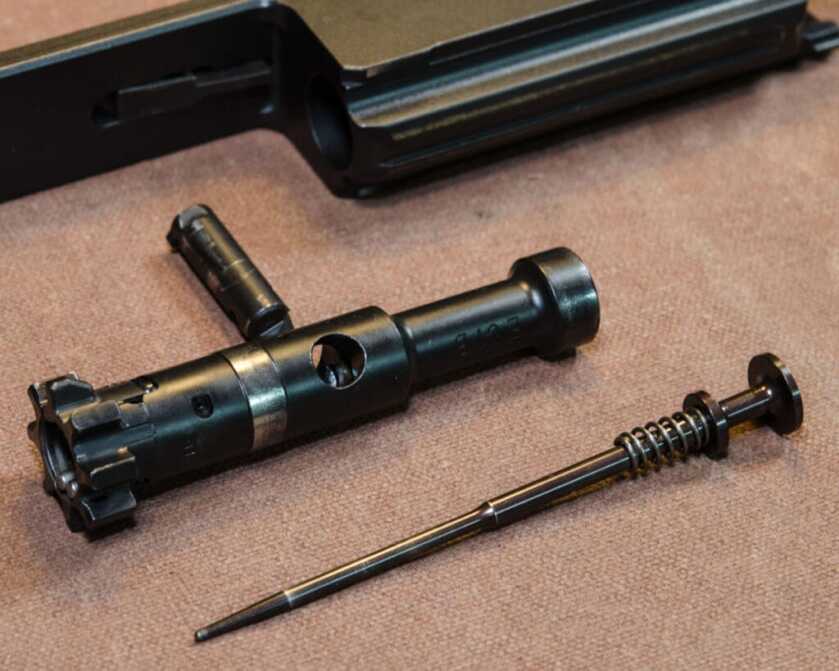

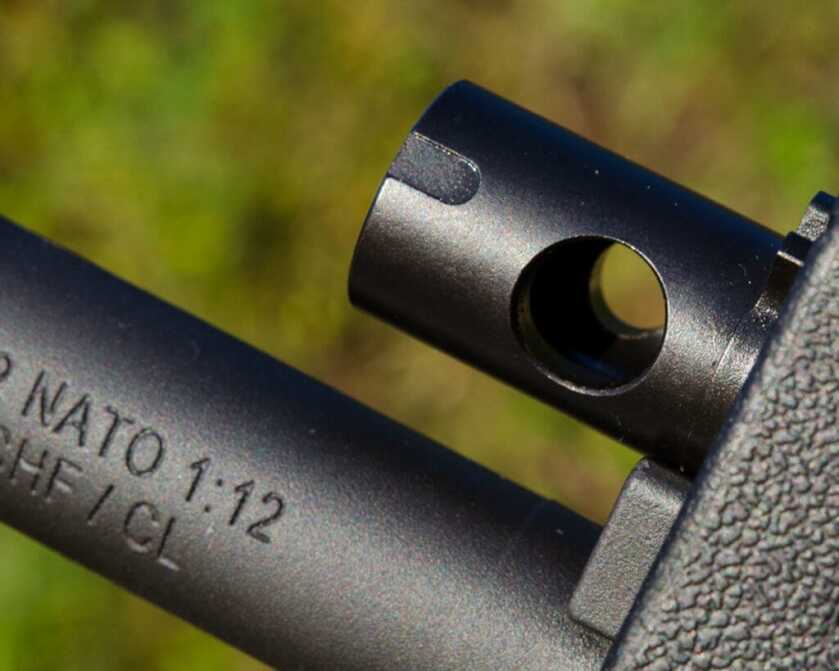
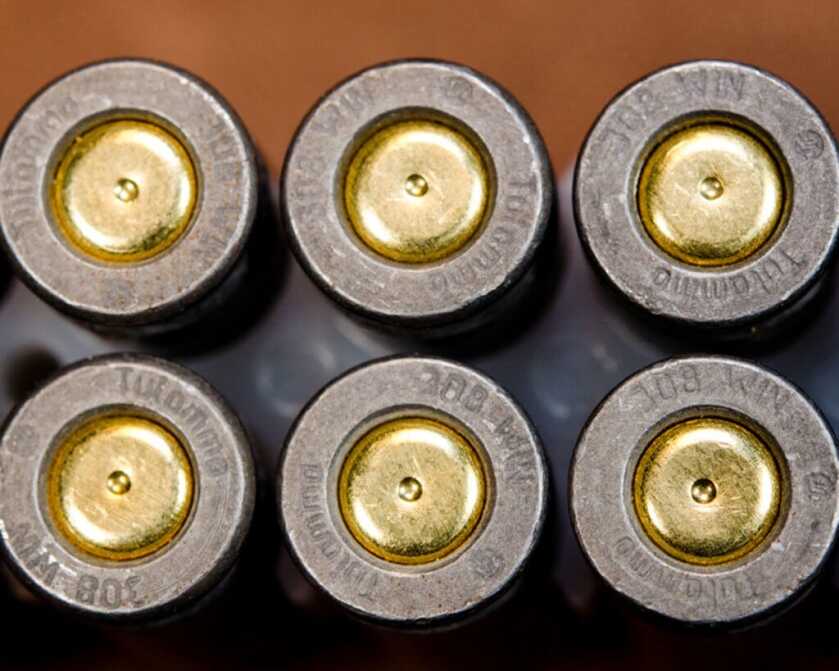

Can anyone identify the swivel/pan bipod he is using? Looks super light and simple, unlike me, heavy and complicated.
Reading this I suddenly realized that one never sees female IDF soldiers on the six o’clock news. They invariably show male IDF soldiers on/near the Gaza strip. HMMmmm….seems to this impartial observer it
would enhance the sympathy effect for Israel if they showed some female soldiers. In this part of the world we
are not too thrilled at the prospect of women being killed and maimed.
That being said I salute our brave female members of the services who also served in combat zones.
Reading this I suddenly realized that one never sees female IDF soldiers on the six o’clock news. They invariably show male IDF soldiers on/near the Gaza strip. HMMmmm….seems to this impartial observer it
After numerous discussions with Jeremy when they were working on the accuracy angle of this rifle – there was no way a 16″ 1:12 bullpup was going to stabilize a heavier round. This is a BATTLE RIFLE, meant to put M80 in center mass at close to mid distances.
This is about seeing a .308 hit a chest, and knowing that target is out of the fight (versus wonder if you need a followup or two with a .223, to make sure they’re not going to keep shooting at you).
We did the expectations/disappointment game on our FB group. Jeremy, the US Sales Rep – is a member of all the main tavor groups, answers questions, etc. – great support from a manufacturers rep. In fact – he helped me get one from the first batch, right from the factory.
I can build an M-14 with a 22″ barrel that will do an MOA or less ALL DAY LONG (my 22″ heavy barrels will do .75 consistently).
This is NOT A THOUSAND YARD GUN. This is NOT a gun that was meant to shoot M118LR. It IS a gun that will run M80 all day long, with extreme reliability and consistent accuracy. Most shooters are seeing 1.5-2.0 – and that’s plenty good.
This is NOT a “squad designated marksman” gun. Yet Military Arms Channel’s Tim – was putting rounds on steel at 250 pretty well (though Tim admittedly gets more range time than most of us).
Any SHTF for me is going to be “up close and personal”, and I want THE POWER that .308 brings to the table, as well as the ergo, versatility and mobility that a Tavor in .308 brings to the game. Anything further out, will see my SCAR-17 or AR-10 Heavy Barrel Match build (which shoots between 1 & .75 with M118LR).
Hell – I can’t SEE ANYTHING past 100 to shoot at it ANYWAYS. I’ll leave that to the guys that are trained to shoot extreme range.
Anyone I need to defend against, is going to be a “run & gun” at closer ranges – and the T-7 is the perfect fit for that tasking.
Rick
I’m not sure what you were expecting from your “top shelf” ammo, but my own experience with 1:12 .308WIN barrels (SCAR 17) have repeatedly demonstrated for me that 1:12 and 168g ammo are not a very accurate combination anyway. As for the cheapo Tula ammo, I picked up a box of Monarch (made of “Much Russia” for Academy) 145g steel case ammo (just to test) and was surprised to find that it produced sub-MOA in my SCAR 17’s 1:12 barrel. NONE of the Hornady or Federal 168g “match” ammo that I have tried would do better than 1.5 MOA in my 1:12 barrel (I use a 24x scope when testing for potential accuracy with factory ammo). So, I have several hundred rounds of 168g ammo that probably shoots fine in a 1:10 barrel but I consider to be near-worthless crap in a 1:12 rifle that usually produces sub-MOA accuracy with ordinary M80 Ball. I’m certainly not a fan of steel case ammo (I usually reload my brass). Regardless, I would imagine that the Tavor 7 was really optimized to shoot military ammo. I would suggest that you test it with M80 Ball (but NOT that crappy IWI stuff) to get a better feel for it’s accuracy potential. Your tests of the gun’s accuracy are disappointing for me. I had high hopes for the Tavor 7 initially, and I was sorely disappointed at the 4 MOA+ accuracy issues with the early release guns. Your 168g testing in that 1:12 barrel certainly reminded me that my SCAR’s 1:12 doesn’t like 168g ammo of ANY make. 130g, 145g, 150g, 155g, & 175g are all okay but not ANY 168g that I have tried. Oddly, Hornady #3045 165g SP bullets do produce sub-MOA for me with 47.0g of BL-C(2) and 47.5g of CFE223 though with the COAL 3 hundredths of an inch shorter than the 168g factory “match” ammo. Yeah, I know you were testing what should have been very accurate factory ammo in the gun, I’m just telling you what works and doesn’t work in my 1:12 twist military-grade barrel. Testing the Tavor with military M80 might bring better results with that 1:12 barrel.
OK as a lefty with a re-attached retina,I need 14.5″l.o.p.1.would this Tavor do so?
2.How does it compare with l/hed Stag 308?
3.Are longer barrels i.e.22″ available?
4.what is the[left hand version]brass ejection-and how violently/far?i.e.I reload the brass
5.How does it compare re reliability/accuracy with a metric FN FAL?[yes I know ty’re right handed]
I have the T7 setup in lefty. Very easy to do. Ejection with M80 is about 10-12 feet in a nice pile at about 7:30 (left side, lol). I have read that a 20″ version will be available. My lop is 16″ and you can mount your optic anywhere along the Picatinny rail.
“…when one does not wish to draw attention to herself….”
Seriously? You’ve watched GI Jane too many times. Pandering, pure and simple. I am all for women shooting, and have introduced a lot of new female shooters. And everyone of them has turned into excellent marksmen. Or marks women, take your pick.
But as a paratrooper, i am sick and tired of everyone acting like women are out there eating snakes, chewing razorwire, and pissing napalm. Lest you site the women in ranger school, for the record, the fix was in, and anyone with a brain knows it, and the ranger school documents prove they were given chances and rules were bent for them to make it.
“Herself”…. yeah.
They do in Israel. If only they used this gun over there…. oh wait! You’d think you would have traveled the world a little more in the army.
Having spent 7 months in the Golan Heights, Israel in 2004 I had opportunity to train with the IDF and I can tell you that the female soldiers would put many a man to shame and still look good doing it. Hard people in a hard environment. After firing the Israeli Tavor I said if one ever made it to Canada I would be first in line!!!
Myron – that is a form or writing, transitioning the reference from one gender to another is simply a way of constructing a writing to be ubiquitous (you can look that word up) to the reader. I don’t pander to anyone – but especially not thick skulled cavemen such as you. I can guarantee that I know women that would put your on your ass and stomp your face. In fact, any real man would encourage and celebrate that many women are self-sufficient and self-reliant – and capable of defending themselves and others. If you doubt me – go ask a real man. Little men, with shortcomings and insecurities might lose their minds over the use of a single pronoun in an article – the most insecure of them might even post a comment ranting about it.
Yikes! Look, I’m all for self reliant women. Women who can defend themselves. My mother is a woman. As far as women who might put me on my ass and/or stomp my face, certainly they do exist. But nobody wants to date a woman with bigger balls than theirs. I appreciate self reliant, and strong women. I also appreciate feminine qualities, in a woman. It should be noted that the Tavor was designed and intended to be utilized on the field of battle by both men and women. IDF chicks are deadly and hot at the same damn time. That said, I believe it was true about qualifications for women in special forces being different. Women are different than men. Were all supposed to work together and compliment each others differences. Maybe we could learn something from our ally.